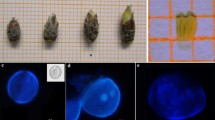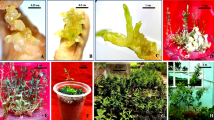Abstract
Embryogenesis and plant regeneration were induced in isolated microspore culture of linseed (oilflax, Linum usitatissimum). Microspores underwent cell divison which led to either microcallus or embryoid formation, when they were cultured in a modified liquid Nitsch-Lichter-Nitsch medium (Lichter 1985) at two different incubation temperatures (30 and 35 °C); some embryoids and microcalli further developed to larger calli. After transfer of the microspore derived calli to a solid medium containing zeatin (Img 1−1) shoot induction was achieved from 36 to 66% of the calli. The highest frequency of regenerated plants was obtained in microspore cultures of the hybrid ‘Atalante’ x ‘Szegedi 62’ (F1) at 30 °C, whereas for the second genotype ‘Pedigree 2’ x ‘Kiszombori 41’ (F2) the higher incubation temperature seemed to be more efficient. Shoots could be successfully rooted on an indole acetic acid containing medium and then transplanted to vermiculite and finally to soil. Most of the plants survived the transfer into soil in the greenhouse, where they could be successfully grown to maturity.
Similar content being viewed by others
Abbreviations
- BAP:
-
6-benzylaminopurine
- 2,4D:
-
dichlorophenoxyacetic acid
- IAA:
-
indole acetic acid
- N6:
-
Chu (1978) medium
- NAA:
-
naphthaleneacetic acid
- NLN:
-
Nitsch-Lichter-Nitsch (1985)
- MS:
-
Murashige and Skoog (1962) medium
- ZEA:
-
zeatin
References
Chu CC (1978) In: Proc Symp Plant Tissue Culture, Beijing, Science Press, pp 43–50
Fan Z, Armstrong KC, Keller WA (1988) Protoplasma 147: 191–199
Huang B, Bird S, Kemble R, Simmonds D, Keller W, Miki B (1990) Plant Cell Reports 8: 594–597
Kappert H (1933) Biol Zbl 53: 276–307
Keller WA, Armstrong KC (1978) Z Pflanzenzüchtg 80: 100–108
Keller WA, Armstrong KC (1983) Euphytica 32: 151–159
Kindinger B, Beckett JB (1985) Stain Technol 60: 265–269
Lichter R (1982) Z Pflanzenphysiol 105: 417–426
Lichter R (1985) In: Nijhoff M and Junk W World Crops Production, Utilization, Description Vol.11: 268–277
Murashige T, Skoog F (1962) Physiol Plant 15: 473–497
Nichterlein K, Umbach H, Friedt W (1989) Vortr Pflanzenzüchtg 15: 25–13
Nichterlein K, Umbach H, Friedt W (1991) Euphytica 58: 157–164
Ockendon DJ (1984) Ann Appl Biol 105: 285–291
Pescitelli SM, Mitchell JC, Jones AM, Pareddy DR, Petolino JF (1989) Plant Cell Reports 7: 673–676
Rajhathy T (1976) Z Pflanzenzüchtg 76: 1–10
Sato T, Nishio T, Hirai M (1989) Plant Cell Reports 8: 486–488
Siebel J, Pauls KP (1989) Theor Appl Genet 78: 473–479
Sun H, Fu W (1981) Acta Genet Sin 8: 369–374
Sunderland N, Xu ZH (1982) J Exp Bot 3: 1086–1095
Author information
Authors and Affiliations
Additional information
Communicated by W. Barz
Rights and permissions
About this article
Cite this article
Nichterlein, K., Friedt, W. Plant regeneration from isolated microspores of linseed (Linum usitatissimum L.). Plant Cell Reports 12, 426–430 (1993). https://doi.org/10.1007/BF00234706
Received:
Revised:
Issue Date:
DOI: https://doi.org/10.1007/BF00234706




